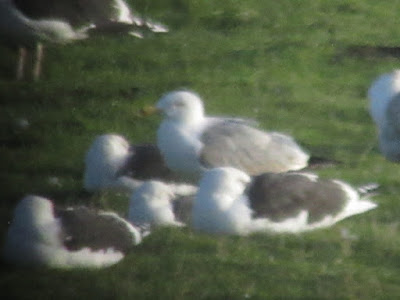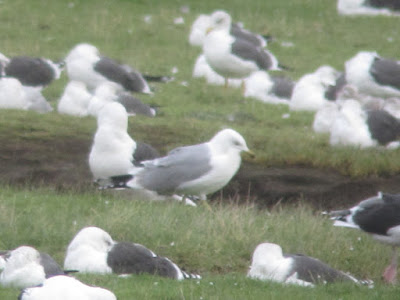Saturday
14 December. Megan and I took Cookie to the Burgh after visiting
Boxgrove Priory Cemetary. Little was showing in the strong wind and
we did a short circuit seeing 9 Grey Partridges, 35 Stock
Doves and single Red Kite, Buzzard and Redwing. Half was round Cookie became nervous of distant shooting and had to be dragged out of
a bush, our return to the car was then faster than normal. The afternoon was spent sorting out 300 gull imges from yesterday ...
Friday 13 December. To get away from the worst election result I can remember and in the hope that a forecast of strong winds and a high tide would be good for gulls I took Cookie to the Lower Cuckmere where we spent four hours. I estimated almost 4000 large gulls were present in three close but distinct groups opposite Harry's Bush, probably the largest number I have seen there. Bright sunshine made it harder for me to pick out anything interesting due to its effect on shades of grey. Many birds were sitting down due to the strong wind which was also unhelpful while not being able to find a sheltered viewpoint made scope shake an issue and a couple of times I was almost blown over. Cookie was largely unaffected being below knee level. Most numerous were Great Black-backed Gulls with at least 2800 including an unread green colour-ringed bird most likely from Normandie.There were 650+ Herring Gulls of which I was happy 8 were argentatus, many others may have been too, and at least 350 Lesser Black-backed Gulls. Almost the first, closest Lesser Black-back I looked at had a blue colour-ring, most likely from Belgium, but it flew before I could read it and was not seen again. I saw eight or nine Yellow-legged Gulls, single first and second winters, two third-winters and four or probably five adults. Also several sleeping gulls with pure white heads and appearing darker mantled than Herring might have been Yellow-legged although quite a few Herrings had developed pure white heads too, as if they weren't hard enough as it was. It was Caspian Gulls I was particularly hoping to see having only convinced myself of a first-winter in four recent(ish) visits. During the time I was present I had three sightings of an adult Caspian Gull and two of first-winters. The first winters looked different at the time and reviewing images later confirmed this and also suggested that at least two of the adults were different, a very satisfactory outcome. I looked at the geese in the Cuckmere including walking up towards Chyngton Farm but only found single Brent and Barnacle amongst the Canada Geese. A Sparrowhawk flew over twice and heard then saw a Raven. The following photos are shown in the order that they were taken. There was little movement to and from the gull flocks and while those there didn't spook very often and some appeared to hardly move others did making it hard to keep tabs on them and work out how many of the scarcer species were actually seen.
 |
| first views of the encouragingly large gull assemblage in the Lower Cuckmere |
 |
| third-winter Yellow-legged Gull, presumably a male given its similar size to the Great Black-backs |
 |
| its appearance changed quite dramatically with its posture here quite Caspian-like |
 |
| and back again to Yellow-legged |
 |
| two adult Yellow-legged Gulls with two Lesser Black-backs, much easier when bright legs are seen |
 |
| adult Caspian Gull, note small head, pallid legs and sagging vent |
 |
| pale bill and dark bullet-hole eye |
 |
| thin pale legs, two presumed argentatus Herring Gulls behind |
 |
| a later bird had a slightly different bill pattern, this one an almost unmarked upper mandible |
 |
| the same bird a few minutes later, the inner tongue of p10 appearing quite dusky |
 |
| small headed and full chested |
 |
| slightly more upright posture |
 |
| extensive left hand and more compact rear flocks |
 |
| rear and straggling right hand flocks |
 |
| first-winter Caspian Gull: snouty, black bill white head and underparts, small dark eye, finely marked grey mantle, brown coverts, white thumbnail tips to tertials and black primaries make this a distinctive bird although it would be nice to have seen its legs |
 |
| it never stood up and soon went to sleep, that all black bill was one of the features differentiating it from the later first-winter seen. Its small head and thick neck evident here. |
 |
| the same bird 10 minutes later in a slightly different part of the flock |
 |
| sleeping again, I continued scanning the flock but it had gone when I looked back and I never saw it again |
 |
| adult Caspian Gull, at the time thought to be the adult seen elsewhere in the flock until 20 minutes earlier |
 |
| long, thin, pale bill, white head, dark bullet-hole eye, long thin washed out legs |
 |
| this bird had a dark mark above the reddish gonal spot appearing as a subterminal back making it different from the earlier individual |
 |
| it also had a more extensive white tip to the underside of p10 and whiter tongue |
 |
| small head and bulging vent visible on this image |
 |
| another or one of the earlier Yellow-legged Gulls, darker mantle, bright bill and reddish eyering give it away, I never saw its legs |
 |
| another stubbier billed Yellow-legged Gull an hour later (we'd taken a break to look for geese) |
 |
| argentatus Herring Gull, note extensive white tip to the underside of p10, darker mantle and streaked head. The two yellow legs belong to a hidden Lesser Black-back immediately behind it |
 |
| presumed Caspian Gull, it had long legs but I never saw much more of it although what I did see looked good - long thin washed out bill, somewhat foreshortened in this image, small dark eye, pure white head, mantle a shade darker than Herring and lighter than Yellow-legged. Possible the first Caspian Gull seen as the upper mandible appeared unmarked. |
 |
| first-winter Caspian Gull - long black wings, white edges to tips of tertials, brownish faintly patterned coverts, greyish lightly marked mantle and white head and underparts |
 |
| very snouty with a dark bill with a paler base making it different from the earlier first-winter seen, very white underneath although a somewhat overexposed image, very long winged |
 |
| it appeared to have fewer dark centres to the upper mantle feathers and paler coverts than the earlier bird too |
 |
| it quickly walked along the channel and out of sight |
 |
| ten minutes later it flew back showing a clean whitish underwing before landing back on the bank and soon went to sleep.Its white hood shows well in this image as do its long legs. For me it was a classic bird. |
 |
| 15 minutes later it moved slightly showing part of its clean underwing. I'd moved position slightly to check through another part of the flock and unfortunately was looking through some thin branches |
 |
| this image shows it legs to good effect, note the first-winter Yellow-legged Gull behind and to its left |
 |
| first-winter Yellow-legged and Caspian Gulls in the Cuckmere |
 |
| a very smart bird, my poor digiscoped images hardly do it justice. What would life be like without birding? |
 |
| colour-ringed Great Black-backed Gull. The wind was too strong to read it at this range although the angle of the ring didn't help. It flew and landed a little closer, but in longer grass with only the top letter S visible before frustratingly flying off out to sea. It is probably from a scheme in Normandie. |
 |
| another or one of the earlier adult Yellow-legged Gulls |
 |
| showing off its legs |
 |
| another third-winter Yellow-legged Gull |
 |
| this one had a darker bill tip than the one first seen although I thought it was the same at the time |
 |
| Seven Sisters from Harry's Bush |
Thursday 12 December. Voting, what a disaster for the environment that turned out to be.
Wednesday 11 December. I took Cookie to Brooklands where we saw male Pochard, 3 Little Grebes, Great Spotted Woodpecker, Chiffchaff, Stonechat and Reed Bunting. Despite a high tide few gulls were in evidence.
 |
| Pochard at Brooklands |
 |
| Reed Bunting at Brooklands |
 |
| always photogenic |














































No comments:
Post a Comment
Note: only a member of this blog may post a comment.